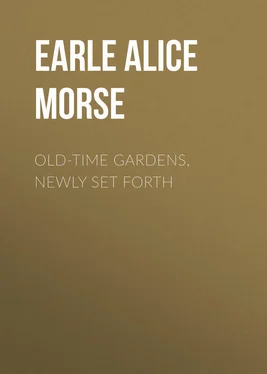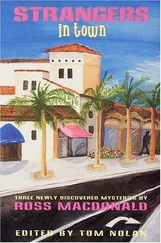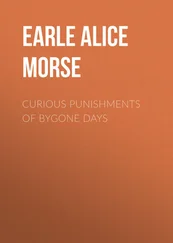Alice Earle - Old-Time Gardens, Newly Set Forth
Здесь есть возможность читать онлайн «Alice Earle - Old-Time Gardens, Newly Set Forth» — ознакомительный отрывок электронной книги совершенно бесплатно, а после прочтения отрывка купить полную версию. В некоторых случаях можно слушать аудио, скачать через торрент в формате fb2 и присутствует краткое содержание. Жанр: foreign_antique, foreign_prose, на английском языке. Описание произведения, (предисловие) а так же отзывы посетителей доступны на портале библиотеки ЛибКат.
- Название:Old-Time Gardens, Newly Set Forth
- Автор:
- Жанр:
- Год:неизвестен
- ISBN:нет данных
- Рейтинг книги:3 / 5. Голосов: 1
-
Избранное:Добавить в избранное
- Отзывы:
-
Ваша оценка:
- 60
- 1
- 2
- 3
- 4
- 5
Old-Time Gardens, Newly Set Forth: краткое содержание, описание и аннотация
Предлагаем к чтению аннотацию, описание, краткое содержание или предисловие (зависит от того, что написал сам автор книги «Old-Time Gardens, Newly Set Forth»). Если вы не нашли необходимую информацию о книге — напишите в комментариях, мы постараемся отыскать её.
Old-Time Gardens, Newly Set Forth — читать онлайн ознакомительный отрывок
Ниже представлен текст книги, разбитый по страницам. Система сохранения места последней прочитанной страницы, позволяет с удобством читать онлайн бесплатно книгу «Old-Time Gardens, Newly Set Forth», без необходимости каждый раз заново искать на чём Вы остановились. Поставьте закладку, и сможете в любой момент перейти на страницу, на которой закончили чтение.
Интервал:
Закладка:
I am as fond of the Peony as are the Chinese, among whom it is flower queen. It is by them regarded as an aristocratic flower; and in old New England towns fine Peony plants in an old garden are a pretty good indication of the residence of what Dr. Holmes called New England Brahmins. In Salem and Portsmouth are old "Pinys" that have a hundred blossoms at a time – a glorious sight. A Japanese name is "Flower-of-prosperity"; another name, "Plant-of-twenty-days," because its glories last during that period of time.
Rhododendrons are to the modern garden what the Peony was in the old-fashioned flower border; and I am glad the modern flower cannot drive the old one out. They are equally varied in coloring, but the Peony is a much hardier plant, and I like it far better. It has no blights, no bugs, no diseases, no running out, no funguses; it doesn't have to be covered in winter, and it will bloom in the shade. No old-time or modern garden is to me fully furnished without Peonies; see how fair they are in this Salem garden. I would grow them in some corner of the garden for their splendid healthy foliage if they hadn't a blossom. The Pæonia tenuifolia in particular has exquisite feathery foliage. The great Tree Peony, which came from China, grows eight feet or more in height, and is a triumph of the flower world; but it was not known to the oldest front yards. Some of the Tree Peonies have finely displayed leafage of a curious and very gratifying tint of green. Miss Jekyll, with her usual felicity, compares its blue cast with pinkish shading to the vari-colored metal alloys of the Japanese bronze workers – a striking comparison. The single Peonies of recent years are of great beauty, and will soon be esteemed here as in China.
Not the least of the Peony's charms is its exceeding trimness and cleanliness. The plants always look like a well-dressed, well-shod, well-gloved girl of birth, breeding, and of equal good taste and good health; a girl who can swim, and skate, and ride, and play golf. Every inch has a well-set, neat, cared-for look which the shape and growth of the plant keeps from seeming artificial or finicky. See the white Peony on page 44; is it not a seemly, comely thing, as well as a beautiful one?
No flower can be set in our garden of more distinct antiquity than the Peony; the Greeks believed it to be of divine origin. A green arbor of the fourteenth century in England is described as set around with Gillyflower, Tansy, Gromwell, and "Pyonys powdered ay betwene" – just as I like to see Peonies set to this day, "powdered" everywhere between all the other flowers of the border.
I am pleased to note of the common flowers of the New England front yard, that they are no new things; they are nearly all Elizabethan of date – many are older still. Lord Bacon in his essay on gardens names many of them, Crocus, Tulip, Hyacinth, Daffodil, Flower de Luce, double Peony, Lilac, Lily of the Valley.
A favorite flower was the yellow garden Lily, the Lemon Lily, Hemerocallis , when it could be kept from spreading. Often its unbounded luxuriance exiled it from the front yard to the kitchen dooryard as befell the clump shown facing page 48. Its pretty old-fashioned name was Liricon-fancy, given, I am told, in England to the Lily of the Valley. I know no more satisfying sight than a good bank of these Lemon Lilies in full flower. Below Flatbush there used to be a driveway leading to an old Dutch house, set at regular intervals with great clumps of Lemon Lilies, and their full bloom made them glorious. Their power of satisfactory adaptation in our modern formal garden is happily shown facing page 76, in the lovely garden of Charles E. Mather, Esq., in Haverford, Pennsylvania.
The time of fullest inflorescence of the nineteenth century front yard was when Phlox and Tiger Lilies bloomed; but the pinkish-orange colors of the latter (the oddest reds of any flower tints) blended most vilely and rampantly with the crimson-purple of the Phlox; and when London Pride joined with its glowing scarlet, the front yard fairly ached. Nevertheless, an adaptation of that front yard bloom can be most effective in a garden border, when white Phlox only is planted, and the Tiger Lily or cultivated stalks of our wild nodding Lily rise above the white trusses of bloom. These wild Lilies grow very luxuriantly in the garden, often towering above our heads and forming great candelabra bearing two score or more blooms. It is no easy task to secure their deep-rooted rhizomes in the meadow. I know a young man who won his sweetheart by the patience and assiduity with which he dug for her all one broiling morning to secure for her the coveted Lily roots, and collapsed with mild sunstroke at the finish. Her gratitude and remorse were equal factors in his favor.
The Tiger Lily is usually thought upon as a truly old-fashioned flower, a veritable antique; it is a favorite of artists to place as an accessory in their colonial gardens, and of authors for their flower-beds of Revolutionary days, but it was not known either in formal garden or front yard, until after "the days when we lived under the King." The bulbs were first brought to England from Eastern Asia in 1804 by Captain Kirkpatrick of the East India Company's Service, and shared with the Japan Lily the honor of being the first Eastern Lilies introduced into European gardens. A few years ago an old gentleman, Mr. Isaac Pitman, who was then about eighty-five years of age, told me that he recalled distinctly when Tiger Lilies first appeared in our gardens, and where he first saw them growing in Boston. So instead of being an old-time flower, or even an old-comer from the Orient, it is one of the novelties of this century. How readily has it made itself at home, and even wandered wild down our roadsides!
The two simple colors of Phlox of the old-time front yard, white and crimson-purple, are now augmented by tints of salmon, vermilion, and rose. I recall with special pleasure the profuse garden decoration at East Hampton, Long Island, of a pure cherry-colored Phlox, generally a doubtful color to me, but there so associated with the white blooms of various other plants, and backed by a high hedge covered solidly with blossoming Honeysuckle, that it was wonderfully successful.
To other members of the Phlox family, all natives of our own continent, the old front yard owed much; the Moss Pink sometimes crowded out both Grass and its companion the Periwinkle; it is still found in our gardens, and bountifully also in our fields; either in white or pink, it is one of the satisfactions of spring, and its cheerful little blossom is of wonderful use in many waste places. An old-fashioned bloom, the low-growing Phlox amœna , with its queerly fuzzy leaves and bright crimson blossoms, was among the most distinctly old-fashioned flowers of the front yard. It was tolerated rather than cultivated, as was its companion, the Arabis or Rock Cress – both crowding, monopolizing creatures. I remember well how they spread over the beds and up the grass banks in my mother's garden, how sternly they were uprooted, in spite of the pretty name of the Arabis – "Snow in Summer."
Sometimes the front yard path had edgings of sweet single or lightly double white or tinted Pinks, which were not deemed as choice as Box edgings. Frequently large Box plants clipped into simple and natural shapes stood at the side of the doorstep, usually in the home of the well-to-do. A great shell might be on either side of the door-sill, if there chanced to be seafaring men-folk who lived or visited under the roof-tree. Annuals were few in number; sturdy old perennial plants of many years' growth were the most honored dwellers in the front yard, true representatives of old families. The Roses were few and poor, for there was usually some great tree just without the gate, an Elm or Larch, whose shadow fell far too near and heavily for the health of Roses. Sometimes there was a prickly semidouble yellow Rose, called by us a Scotch Rose, a Sweet Brier, or a rusty-flowered white Rose, similar, though inferior, to the Madame Plantier. A new fashion of trellises appeared in the front yard about sixty years ago, and crimson Boursault Roses climbed up them as if by magic.
Читать дальшеИнтервал:
Закладка:
Похожие книги на «Old-Time Gardens, Newly Set Forth»
Представляем Вашему вниманию похожие книги на «Old-Time Gardens, Newly Set Forth» списком для выбора. Мы отобрали схожую по названию и смыслу литературу в надежде предоставить читателям больше вариантов отыскать новые, интересные, ещё непрочитанные произведения.
Обсуждение, отзывы о книге «Old-Time Gardens, Newly Set Forth» и просто собственные мнения читателей. Оставьте ваши комментарии, напишите, что Вы думаете о произведении, его смысле или главных героях. Укажите что конкретно понравилось, а что нет, и почему Вы так считаете.












